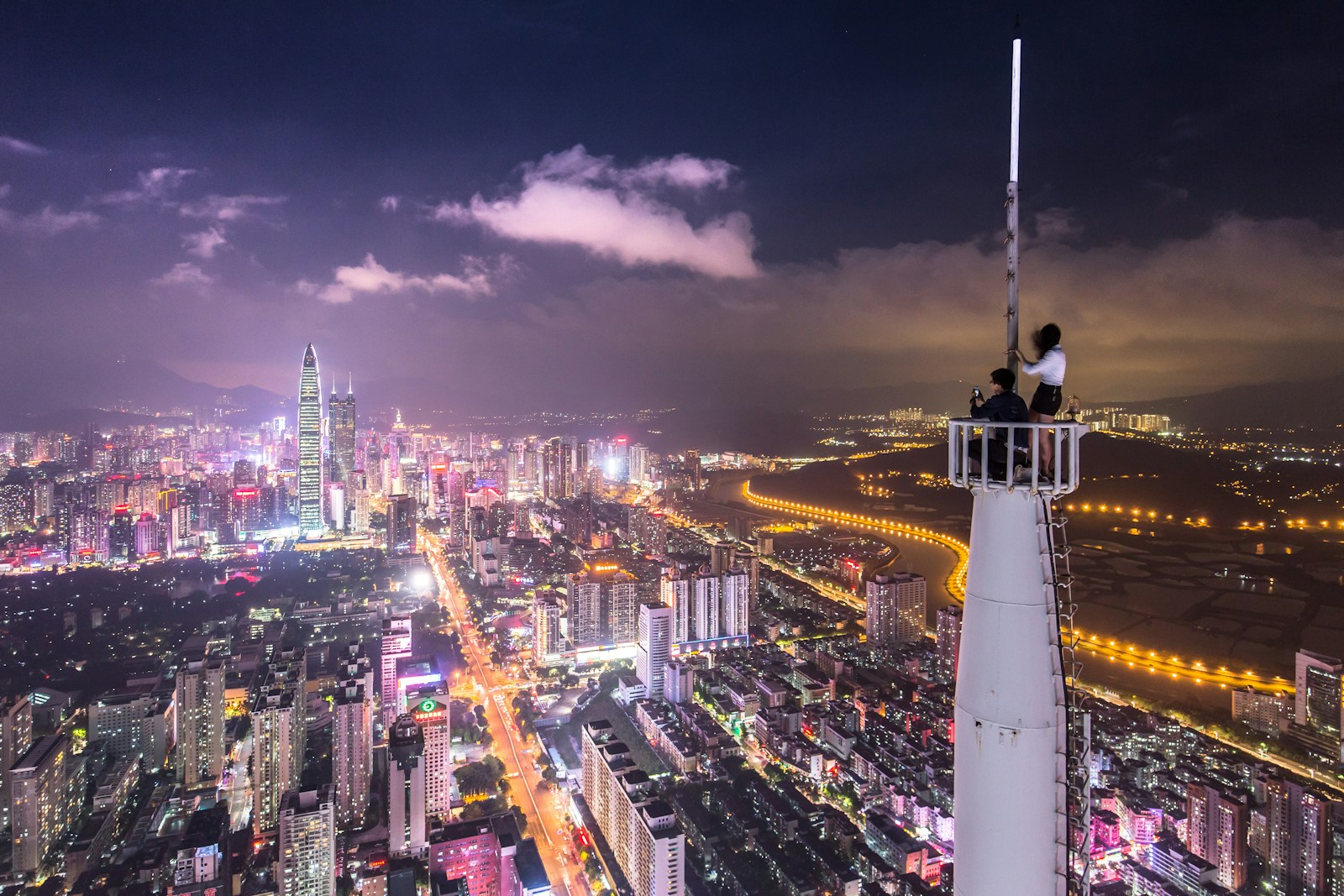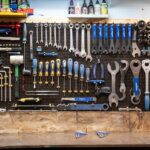Shenzhen at night feels like the future made real.
Towers turn into giant digital screens.
Drones hum overhead.
Robotaxis slide past with no driver at the wheel.
Not long ago, this place was a quiet border town of farms and fishing boats. In 1980 it became China’s first Special Economic Zone, an early test of market reforms.
Today, the wider urban area holds well over 13 million people, and some estimates for the full administrative city run closer to 17 million residents.
People now call it China’s Silicon Valley and the Silicon Valley of hardware.
We see why the moment we step onto its streets.
From Fishing Village To Silicon Valley Of Hardware
In the 1970s, this area beside Hong Kong was mainly farmland and small villages.
Shenzhen became a Special Economic Zone in 1980. The goal was simple.
Open the door.
Invite in factories, investors, and new ideas.
Factories came first.
Then came engineers, designers, and start-ups.
Step by step, the city moved from low-cost assembly lines to high-end innovation.
Now Shenzhen is home to global tech names like Huawei, Tencent, DJI, and BYD.
- Huawei builds phones, 5G gear, and is now working on advanced chip SEC Roll Call production lines in the city.
- Tencent runs WeChat and huge online games from its high-tech campus in Nanshan.
- DJI leads the world in consumer drones, with its headquarters here.
- BYD builds electric cars and buses and has turned Shenzhen into a major vehicle manufacturing center.
In other words, the city now feels like one big hardware lab.
Ideas move from sketch to prototype to mass production in very little time.
First Stop: Drone Delivery Above The Streets
In many cities, drones feel like a demo.
In Shenzhen, they feel like part of daily life.
Chinese delivery giant Meituan has been testing and running drone delivery routes in the city since the early 2020s. Its drones now complete hundreds of thousands of orders, with average delivery times near 15 minutes.
By 2025, Meituan even rolled out night-time drone delivery, with flights over dense urban areas, including parts of Shenzhen and the Greater Bay Area.
Picture this simple scene.
We stand on a rooftop pickup point in a busy district.
Far below, electric buses and cars slide along wide roads.
Above us, a small hexagon-shaped drone appears as a soft buzz in the dark.
It drops onto a landing pad, opens a small hatch, and places dinner or groceries into a locker.
A phone buzzes with a code. Where Are DEWALT Tools Made?
We walk up, tap the screen, grab our order, and walk away.
Instead of fighting street traffic, the delivery hops over it.
This saves time and also reduces the number of scooters weaving through crowded lanes.
Shenzhen’s dense layout and strong tech base make it an ideal testbed.
Companies use the city’s mix of skyscrapers, parks, and planned neighborhoods to refine routing, safety, and noise controls.
Next Ride: A Driverless Taxi In A Real City
On the ground, Shenzhen also pushes hard on robotaxis.
Autonomous driving firms such as Pony.ai, AutoX, and Baidu’s Apollo Go all run services here or in nearby cities.
In 2024, Baidu’s Apollo Go expanded across many Chinese cities, building one of the largest robotaxi fleets in the world.
By late 2025, Pony.ai received the monstera plant first citywide permit for fully driverless commercial robotaxis in Shenzhen, with support from a major local taxi group. The first focus zones include smart districts like Nanshan, Qianhai, and Baoan, with planned expansion across the city.
The experience feels very simple from the passenger side.
We open an app.
We drop a pin at our corner and another at a tech park near the bay.
A white SUV with sensors and lidars gliding on the roof pulls up to the curb.
The door unlocks with a soft chime.
Inside, there is no human driver.
Screens show our route and speed.
The car eases into traffic.
It slows near pedestrians and bikes.
It takes clean turns and handles roundabouts with calm control.
We move through a real, busy Chinese megacity in a vehicle that steers itself.
The trip feels almost boring, which is exactly the point.
For Shenzhen, robotaxis are not just about impressing visitors. They are about:
- Reducing crashes over time
- Collecting data to improve mapping and traffic flow
- Cutting emissions by pairing autonomy with electric drivetrains
Instead of a wild experiment, the service sedum makinoi ogon becomes another part of the public transport mix.
A Walk Through The Robot And Gadget Showrooms
Shenzhen does not hide its machines.
It puts them on display.
Across the city’s tech parks and malls, we find robotics showrooms, demo centers, and smart stores that feel like small theme parks for engineers.
In Nanshan’s High-Tech Industrial Park and similar zones, companies display:
- Delivery robots rolling along smooth floors
- Robotic arms sorting tiny parts on conveyor belts
- Service robots that greet guests, pour drinks, or guide visitors
- Drone cages where quadcopters fly safe indoor patterns
Some robots handle factory work behind glass.
Others serve coffee or ice cream to curious shoppers.
The line between lab and store blurs.
Products sit next to prototypes.
Here, it becomes clear why Shenzhen has its special Rust-Free Tools nickname.
The city is famous not only for software and apps but also for physical devices.
Boards, chips, sensors, motors, and cases all live one bus ride apart.
Huaqiangbei: The Electronics Market That Feels Like A Giant Circuit Board
To really feel the hardware spirit, we head to Huaqiangbei, a dense district of electronics markets in Futian.
Huaqiangbei is widely known as one of the largest electronics markets in the world and is often called China’s Silicon Valley of hardware or the No.1 Electronic Street in China.
Inside its towers and malls, we find:
- Stalls selling chips, sensors, cables, and batteries
- Small shops that can design and print a custom circuit board
- Phone repair benches stacked with tiny tools and spare screens
- Stalls full of drones, cameras, LED panels, and smart home devices
Entrepreneurs from all over the world come here.
They source parts for prototypes.
They test new component suppliers.
If a designer has an idea for a new gadget, Huaqiangbei calliope flower can turn that idea into a physical object in days, not months.
The market also shows the challenges of fast innovation.
Alongside official products, second-hand and grey-market devices move through the same halls, feeding a huge repair and recycling ecosystem.
In other words, this district is the beating heart of Shenzhen’s maker culture, with all its strengths and its shadows.
When Night Falls: Cyberpunk Skies Over Futian
As the sun sets, Shenzhen does something special.
It turns the skyline into one big synchronized screen.
In the central Futian district, around the Civic Center, more than forty skyscrapers light up together. About 43 buildings and over a million LED light panels create animated patterns across the facades.
Shows usually run several times each evening on Fridays, Saturdays, and major Chinese holidays, with timed slots in both cool and warm seasons.
We stand in the main square with thousands of residents.
Music starts.
One by one, buildings shift from normal office lights to smooth better boy blocks of color.
A wave of blue rolls down the row of towers.
Then pink and gold flow upward like digital fireworks.
Sometimes the show displays city stories.
Trains, bridges, slogans, and stylized mountains glide along the walls.
Drones join the performance on special nights.
Past events have used thousands of synchronized drones above Shenzhen to create shapes, words, and moving figures in the sky.
The result feels like walking into a cyberpunk film, except this is real city life.
Families sit on steps with snacks.
Kids chase each other between tripods and smartphones.
Street performers play to the crowd.
Instead of hiding technology in back rooms, Shenzhen paints it across its skyline.
Daily Life In A Fully Wired City
Beyond the showpieces, everyday life in Shenzhen runs on quiet tech.
Subways and buses use contactless and mobile payments almost everywhere.
Delivery vans share lanes with last-mile robots.
Many buildings connect to smart city systems that monitor traffic carolina reaper, power use, and public safety.
Coworking spaces and incubators sit inside former factory zones.
Start-ups work down the hall from global giants.
In Nanshan and Qianhai, tech campuses host labs for AI, robotics, and clean energy, helped by local government support and investors.
At the same time, the city still faces challenges.
- Housing and office growth push land prices up
- The pace of work can be intense for young engineers and factory workers
- Global trade tensions and tech export rules add pressure to local firms like Huawei and BYD
Yet the energy stays strong.
Shenzhen keeps drawing talent from across China and from other countries.
The promise remains clear.
If we bring a new idea here, we can build it fast.
Tips For Experiencing Shenzhen’s Futuristic Side
A short visit can already give us a strong feel for this future city.
Focus on a few key zones
- Futian Civic Center for the light shows and a central view of the skyline
- Nanshan High-Tech Park for tech campuses and robot showrooms
- Huaqiangbei for vinca flower electronics markets and DIY hardware culture
Try at least one smart service
We can:
- Order a drone delivery from a supported restaurant or store, if our location fits one of Meituan’s routes
- Book a robotaxi ride through an authorized app in the active service zones, once we meet local rules and registration steps
Blend old and new streets
Between towers, we still find small food stalls, parks, and older blocks that remind us of the city’s village past.
Walking both the glass-and-steel canyons and the side lanes gives a fuller picture.
Instead of seeing only shiny surfaces, we see people at work, at rest, and in motion.
We see the human side of a very high-tech place.
Where Neon Streets Meet Tomorrow
Shenzhen in 2025 stands at an interesting crossroads.
It is no longer just a copycat factory town.
It is a place where drones bring dinner, robotaxis carry riders, and skyscrapers become shared digital canvases every weekend.
The city shows what happens when policy, capital, and raw energy celebrity tomato line up around technology and manufacturing.
It also hints at the future shape of other big cities, from Dubai to Austin, as they test similar tools.
When we ride a driverless taxi through Nanshan or stand under the light show in Futian, we feel something simple and strong.
The future is not a distant dream.
It is already here, running routes, flashing across towers, and landing quietly on rooftops with takeout in its cargo bay.
Shenzhen wraps that future in neon, steel, and human hustle.
Walking through it, we step into a living preview of what connected cities can become.




